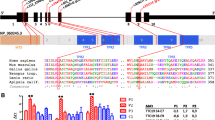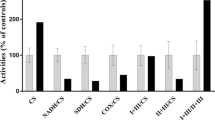Abstract
TFG (tropomyosin-receptor kinase fused gene) encodes an essential protein in the regulation of vesicular trafficking between endoplasmic reticulum and Golgi apparatus. The homozygous variant c.316C > T within TFG has been previously associated with a complicated hereditary spastic paraplegia (HSP) phenotype in two unrelated Indian families. Here, we describe the first Italian family with two affected siblings harboring the same variant, who in childhood were classified as infantile neuroaxonal dystrophy (INAD) based on clinical and neuropathological findings. Twenty years after the first diagnosis, exome sequencing was instrumental to identify the genetic cause of this disorder and clinical follow-up of patients allowed us to reconstruct the natural history of this clinical entity. Investigations on patient’s fibroblasts demonstrate the presence of altered mitochondrial network and inner membrane potential, associated with metabolic impairment. Our study highlights phenotypic heterogeneity characterizing individuals carrying the same pathogenic variant in TFG and provides an insight on tight connection linking mitochondrial efficiency and neuronal health to vesicular trafficking.



Similar content being viewed by others
References
Johnson A, Bhattacharya N, Hanna M, Pennington JG, Schuh AL, Wang L, Otegui MS, Stagg SM, Audhya A (2015) TFG clusters COPII-coated transport carriers and promotes early secretory pathway organization. EMBO J 34(6):811–827. https://doi.org/10.15252/embj.201489032
Yagi T, Ito D, Suzuki N (2016) TFG-related neurologic disorders: new insights into relationships between endoplasmic reticulum and neurodegeneration. J Neuropathol Exp Neurol 75(4):299–305. https://doi.org/10.1093/jnen/nlw009
Ishiura H, Sako W, Yoshida M, Kawarai T, Tanabe O, Goto J, Takahashi Y, Date H, Mitsui J, Ahsan B, Ichikawa Y, Iwata A, Yoshino H, Izumi Y, Fujita K, Maeda K, Goto S, Koizumi H, Morigaki R, Ikemura M, Yamauchi N, Murayama S, Nicholson GA, Ito H, Sobue G, Nakagawa M, Kaji R, Tsuji S (2012) The TRK-fused gene is mutated in hereditary motor and sensory neuropathy with proximal dominant involvement. Am J Hum Genet 91(2):320–329. https://doi.org/10.1016/j.ajhg.2012.07.014
Lee SS, Lee HJ, Park JM, Hong YB, Park KD, Yoo JH, Koo H, Jung SC, Park HS, Lee JH, Lee MG, Hyun YS, Nakhro K, Chung KW, Choi BO (2013) Proximal dominant hereditary motor and sensory neuropathy with proximal dominance association with mutation in the TRK-fused gene. JAMA Neurol 70(5):607–615. https://doi.org/10.1001/jamaneurol.2013.1250
Alavi A, Shamshiri H, Nafissi S, Khani M, Klotzle B, Fan JB, Steemers F, Elahi E (2015) HMSN-P caused by p.Pro285Leu mutation in TFG is not confined to patients with far east ancestry. Neurobiol Aging 36(3):1606.e1–1606.e7. https://doi.org/10.1016/j.neurobiolaging.2014.11.021
Yagi T, Ito D, Suzuki N (2014) Evidence of TRK-fused gene (TFG1) function in the ubiquitin-proteasome system. Neurobiol Dis 66:83–91. https://doi.org/10.1016/j.nbd.2014.02.011
Tsai PC, Huang YH, Guo YC, Wu HT, Lin KP, Tsai YS, Liao YC, Liu YT, Liu TT, Kao LS, Yet SF, Fann MJ, Soong BW, Lee YC (2014) A novel TFG mutation causes Charcot-Marie-Tooth disease type 2 and impairs TFG function. Neurology 83(10):903–912. https://doi.org/10.1212/WNL.0000000000000758
Khani M, Shamshiri H, Alavi A, Nafissi S, Elahi E (2016) Identification of novel TFG mutation in HMSN-P pedigree: emphasis on variable clinical presentations. J Neurol Sci 369:318–323. https://doi.org/10.1016/j.jns.2016.08.035
Beetz C, Johnson A, Schuh AL, Thakur S, Varga RE, Fothergill T, Hertel N, Bomba-Warczak E, Thiele H, Nürnberg G, Altmüller J, Saxena R, Chapman ER, Dent EW, Nürnberg P, Audhya A (2013) Inhibition of TFG function causes hereditary axon degeneration by impairing endoplasmic reticulum structure. Proc Natl Acad Sci U S A 110(13):5091–5096. https://doi.org/10.1073/pnas.1217197110
Harlalka GV, McEntagart ME, Gupta N, Skrzypiec AE, Mucha MW, Chioza BA, Simpson MA, Sreekantan-Nair A, Pereira A, Günther S, Jahic A, Modarres H, Moore-Barton H, Trembath RC, Kabra M, Baple EL, Thakur S, Patton MA, Beetz C, Pawlak R, Crosby AH (2016) Novel genetic, clinical, and pathomechanistic insights into TFG-associated hereditary spastic paraplegia. Hum Mutat 37(11):1157–1161. https://doi.org/10.1002/humu.23060
Elsayed LE, Mohammed IN, Hamed AA, Elseed MA, Johnson A, Mairey M, Mohamed HE, Idris MN, Salih MA, El-Sadig SM, Koko ME, Mohamed AY, Raymond L, Coutelier M, Darios F, Siddig RA, Ahmed AK, Babai AM, Malik HM, Omer ZM, Mohamed EO, Eltahir HB, Magboul NA, Bushara EE, Elnour A, Rahim SM, Alattaya A, Elbashir MI, Ibrahim ME, Durr A, Audhya A, Brice A, Ahmed AE, Stevanin G (2016) Hereditary spastic paraplegias: identification of a novel SPG57 variant affecting TFG oligomerization and description of HSP subtypes in Sudan. Eur J Hum Genet 25(1):100–110. https://doi.org/10.1038/ejhg.2016.108
Tariq H, Naz S (2017) TFG associated hereditary spastic paraplegia: an addition to the phenotypic spectrum. Neurogenetics 18(2):105–109. https://doi.org/10.1007/s10048-017-0508-6
Invernizzi F, D’Amato I, Jensen PB, Ravaglia S, Zeviani M, Tiranti V (2012) Microscale oxygraphy reveals OXPHOS impairment in MRC mutant cells. Mitochondrion 12(2):328–335. https://doi.org/10.1016/j.mito.2012.01.001
Magini P, Pippucci T, Tsai IC, Coppola S, Stellacci E, Bartoletti-Stella A, Turchetti D, Graziano C, Cenacchi G, Neri I, Cordelli DM, Marchiani V, Bergamaschi R, Gasparre G, Neri G, Mazzanti L, Patrizi A, Franzoni E, Romeo G, Bordo D, Tartaglia M, Katsanis N, Seri M (2014) A mutation in PAK3 with a dual molecular effect deregulates the RAS/MAPK pathway and drives an X-linked syndromic phenotype. Hum Mol Genet 23(13):3607–3617
Pippucci T, Benelli M, Magi A, Martelli PL, Magini P, Torricelli F, Casadio R, Seri M, Romeo G (2011) EX-HOM (EXome HOMozygosity): a proof of principle. Hum Hered 72:45–53
Magi A, Tattini L, Palombo F, Benelli M, Gialluisi A, Giusti B, Abbate R, Seri M, Gensini GF, Romeo G, Pippucci T (2014) H3M2: detection of runs of homozygosity from whole-exome sequencing data. Bioinformatics 30:2852–2859
Bugiani M, Invernizzi F, Alberio S, Briem E, Lamantea E, Carrara F, Moroni I, Farina L, Spada M, Donati MA, Uziel G, Zeviani M (2004) Clinical and molecular findings in children with complex I deficiency. Biochim Biophys Acta 1659:136–147
Tiranti V, Galimberti C, Nijtmans L, Bovolenta S, Perini MP, Zeviani M (1999) Characterization of SURF-1 expression and Surf-1p function in normal and disease conditions. Hum Mol Genet 8:2533–2540. https://doi.org/10.1093/hmg/8.13.2533
Nardocci N, Zorzi G, Farina L, Binelli S, Scaioli W, Ciano C, Verga L, Angelini L, Savoiardo M, Bugiani O (1999) Infantile neuroaxonal dystrophy: clinical spectrum and diagnostic criteria. Neurology 52(7):1472–1478
Morgan NV, Westaway SK, Morton JE, Gregory A, Gissen P, Sonek S, Cangul H, Coryell J, Canham N, Nardocci N, Zorzi G, Pasha S, Rodriguez D, Desguerre I, Mubaidin A, Bertini E, Trembath RC, Simonati A, Schanen C, Johnson CA, Levinson B, Woods CG, Wilmot B, Kramer P, Gitschier J, Maher ER, Hayflick SJ (2006) PLA2G6, encoding a phospholipase A2, is mutated in neurodegenerative disorders with high brain iron. Nat Genet 38(7):752–754 Erratum in: Nat Genet 2006 Aug;38(8):957
Witte K, Schuh AL, Hegermann J, Sarkeshik A, Mayers JR, Schwarze K, Yates JR 3rd, Eimer S, Audhya A (2011) TFG-1 function in protein secretion and oncogenesis. Nat Cell Biol 13(5):550–558. https://doi.org/10.1038/ncb2225
Ozes B, Karagoz N, Schüle R, Rebelo A, Sobrido MJ, Harmuth F, Synofzik M, Pascual SIP, Colak M, Ciftci-Kavaklioglu B, Kara B, Ordóñez-Ugalde A, Quintáns B, Gonzalez MA, Soysal A, Zuchner S, Battaloglu E (2017) PLA2G6 mutations associated with a continuous clinical spectrum from neuroaxonal dystrophy to hereditary spastic paraplegia. Clin Genet 92(5):534–539. https://doi.org/10.1111/cge.13008
Chen YJ, Chen YC, Dong HL, Li LX, Ni W, Li HF, Wu ZY (2018) Novel PLA2G6 mutations and clinical heterogeneity in Chinese cases with phospholipase A2-associated neurodegeneration. Parkinsonism Relat Disord 49:88–94. https://doi.org/10.1016/j.parkreldis.2018.02.010
Kanadome T, Shibata H, Kuwata K, Takahara T, Maki M (2017) The calcium-binding protein ALG-2 promotes endoplasmic reticulum exit site localization and polymerization of Trk-fused gene (TFG) protein. FEBS J 284(1):56–76. https://doi.org/10.1111/febs.13949
Hanna MG, Block S, Frankel EB, Hou F, Johnson A, Yuan L, Knight G, Moresco JJ, Yates JR 3rd, Ashton R, Schekman R, Tong Y, Audhya A (2017) TFG facilitates outer coat disassembly on COPII transport carriers to promote tethering and fusion with ER-Golgi intermediate compartments. Proc Natl Acad Sci U S A 114(37):E7707–E7716. https://doi.org/10.1073/pnas.1709120114.
Acknowledgements
We are grateful to the patients and their family for their participation and contribution in this study. We also thank Dr. Giaccone for helping with the biopsy report and images.
Funding
This study received support from the Mariani Foundation of Milan.
Author information
Authors and Affiliations
Corresponding author
Ethics declarations
The ethic board of the Scientific Institute Stella Maris (Pisa) approved the study and informed consent was obtained according to the Declaration of Helsinki from all the subjects involved.
Conflict of interest
The authors declare that they have no conflict of interest.
Electronic supplementary materials
Supplementary Figure 1
Follow-up brain MRI of subject II-3. a–e Subject II-3. Axial (a, d) and coronal (b) FAST T2-weighted images show reduction of the supratentorial white matter, lateral ventricle enlargement, and large subarachnoid spaces as the effect of diffuse atrophy, middle cerebellar peduncle hypoplasia (star), and enlargement of the IV ventricle. Coronal image (c) shows possible hypoplasia of the optic chiasm (white arrow). e Sagittal image reveals thin corpus callosum (thin white arrow) and small brainstem. FAST imaging was required due to low patient compliance to the MRI exam. f–l Subject 2 (healthy control, matched for age) for comparison. Normal axial, coronal, and sagittal FAST T2-weighted images. (PDF 834 kb)
Supplementary Figure 2
TFG expression and assembly in patient’s fibroblasts. a Patient and controls protein samples resolved in 10% SDS/PAGE gel after incubation with anti-TFG antibody. GAPDH was used as loading control. b Densitometric analysis of WB. c Blue native gels stained for TFG protein and CO1 (Cytochrome c oxidase subunit 1) used as loading control. d Densitometric analysis of BN. Numbers of kilodaltons are given on left of gels. WB, western blot; BN, blue native (PDF 156 kb)
Supplementary Figure 3
Sub-cellular distribution of TFG in patient’s fibroblasts. Control (a, b, c) and patient (d, e, f) fixed fibroblasts after double staining with Mitotracker red (a–d), KDEL antibody (green in b–e), GM130 antibody (green in c–f), and TFG-specific antibody (green in a–d, red in b, c, e, f). To-Pro3 fluorescent dye (blue) was used for nuclear counterstaining. Original magnification of all images is × 63. Higher magnification views of the indicated regions (boxed) are also shown. The scale bars represent 30 μm (main) and 5 μm (inset). (PDF 934 kb)
Rights and permissions
About this article
Cite this article
Catania, A., Battini, R., Pippucci, T. et al. R106C TFG variant causes infantile neuroaxonal dystrophy “plus” syndrome. Neurogenetics 19, 179–187 (2018). https://doi.org/10.1007/s10048-018-0552-x
Received:
Accepted:
Published:
Issue Date:
DOI: https://doi.org/10.1007/s10048-018-0552-x




